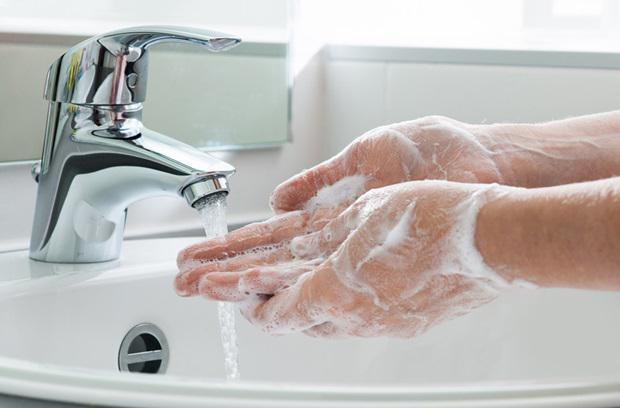
- posted: Nov. 30, 2019
… And might we add your cheapest, too? This involves no pricy prescriptions, scary injections or even exotic superfoods from far off lands. If you’re still scratching your head, here are a few additional clues:1
- It takes 20 seconds to do, though 40-60 seconds is recommended.
- It can prevent 30% of diarrhea-related sicknesses and 20% of respiratory infections (e.g., colds).
- People who do this have 24% less sick days because of respiratory illness and 51% fewer sick days due to a stomach virus.
- Less than 75% of women and 50% of men do this after using the restroom.
We hope you found the last one to be a dead giveaway, and also hope you’re not contributing to those statistics! Consistent handwashing is critical for preventing infection from all types of pathogens (e.g., viruses, bacteria, fungi and parasites) and is why the first week of December is dedicated to raising national awareness about handwashing. Our ultimate aim at Family Practice Associates in Broomfield, Colorado is to keep you healthy, and while we love when our patients come to see us, we don’t love to see them sick. Read below to learn why handwashing is a habit you never want to break.
History of handwashing
Contrary to what you might presume, handwashing has not always been a mode of good hygiene. Before the validation and popularization of germ theory in the 1850s, people had no reason to wash their hands to prevent disease transmission, as it was believed foul odors or evil spirits were responsible for most illnesses.2 Toward the end of the 19th century, however, soap began appearing on the market after its manufacturers decided to broadcast the health benefits of handwashing for financial gain. This practice soon became commonplace and was leveraged to propel upgrades in sanitation treatments during World War II that not only helped tilt victory in favor of the Allied Powers, it led to the establishment of the Centers for Disease Control and Prevention (CDC). In 1981, handwashing was officiated as a public health mandate and has remained ever since.3
How to properly wash your hands
Multiple healthcare organizations recommend spending 40-60 seconds washing your hands with soap and water, then drying them completely to ensure a proper cleaning. To help you along, the CDC has broken this process down into five easy steps, delineated below:
- Wet your hands with clean, running water.
- Lather soap all over your palms and the back of your hands, in between your fingers and under your nails (the latter being the resident hideout for most bacteria).
- Scrub a dub dub your hands for at least 20 seconds (bonus points if you also recite the alluded nursery rhyme aloud, although we can’t guarantee it will make the process more effective).
- Rinse your hands with clean, running water.
- Dry your hands with a clean towel or hand drying machine.
Note: Because we can read minds (it comes with our profession), we would be remiss if we neglected to address whether using hand sanitizer could be used instead of soap and water. The answer is … kind of. If your hands are visibly befouled, it is best to give them a thorough washing to dislodge – and rinse off (!) – the bacteria trapped in the dirt, grease and natural oils covering your hands. Failing access to soap and water, choose a hand sanitizer with at least 60% alcohol according to the product’s label. It won’t get down and dirty like its predecessor, but will certainly suffice for the situation at – or rather, on, your hands.
Staying on guard
If handwashing, arguably, is the most affordable way to prevent getting sick, do you know the most expensive way to GET sick? Believe it or not, it’s probably lurking in your wallet as we speak. Several investigations have reported that dollar bills harbor more disease-causing agents than public toilets because few individuals wash their hands prior to or after touching them, adding a new flavor to the concepts of ‘filthy rich’ and ‘dirty money’.4-5 We don’t say this to alarm you, but to further underscore why handwashing should be carried out with utmost vigilance, even in the most benign or unsuspecting of circumstances. Pamela Abrams, MD, at Family Practice Associates and the entire staff at Family Practice Associates always want their patients to be informed of the best practices for staying well at all times and in every measure – and not just because we don’t want your money – we don’t like getting sick either, you know. Until next time, happy handwashing. :)
Brenda Burgess, PhD in Nutritional Biochemistry & Physiology (Dr. Pamela Abrams' niece)
References
- National Day Calendar 2019. “National Hand Washing Awareness Week – First Full Week of December.” (2019). Retrieved from https://nationaldaycalendar.com/national-hand-washing-awareness-week-first-full-week-in-december/.
- Hodkinson, J. “The history of germ theory.” (2015). Retrieved from https://bigpictureeducation.com/history-germ-theory.
- Thomas, V. “History of Handwashing (1800s – Present).” (n.d.). Retrieved from http://history-of-handwashing.leadr.msu.edu/new-public-health/.
- Maritz, J., Sullivan, S., Prill, R., Aksoy, E., Scheid, P., Carlton, J. (2017). “Filthy lucre: A metagenomic pilot study of microbes found on circulating currency in New York City.” PLoS One. 12(4), e0175527.
- Pope, T., Ender P., Woelk W., Koroscil M., Koroscil T. (2002). “Bacterial contamination of paper currency.” Southern Medical Journal. 95(12), 1408-10.
Locations
433 Summit Blvd Suite 201
Broomfield, CO 80021, US
(303) 673-9195
Hours of Operation
Our Regular Schedule
Opening hours
8:00 am - 5:00 pm
8:00 am - 5:00 pm
8:00 am - 5:00 pm
8:00 am - 5:00 pm
8:00 am - 5:00 pm
Closed
Closed
Opening hours
